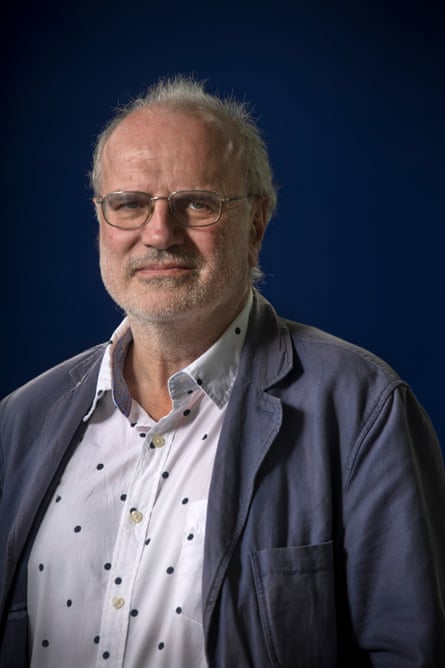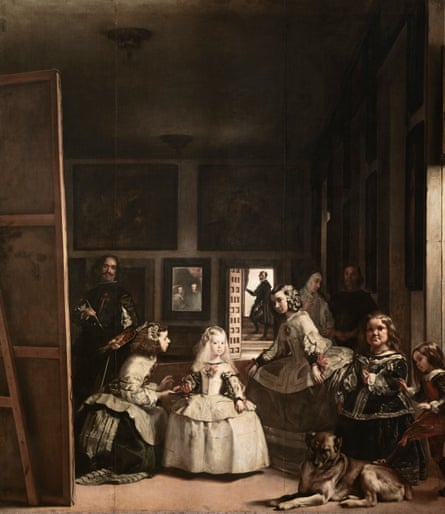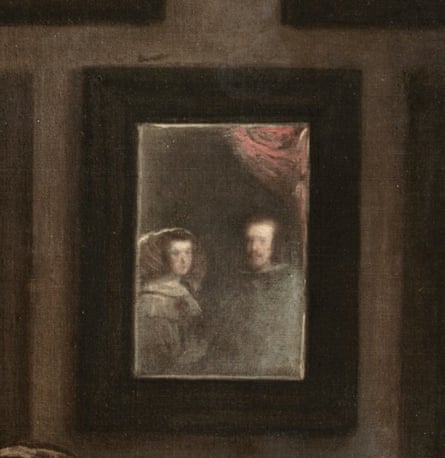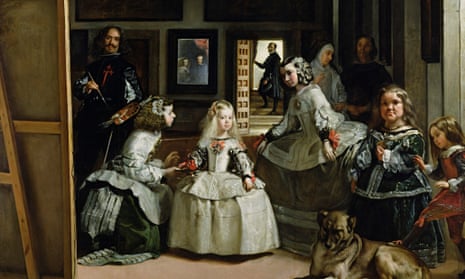The envelope, postmarked Madrid, torn slightly on the lefthand corner, released, on opening, the pieces of a puzzle. “A jigsaw postcard,” explained a handwritten note inserted amidst the scrambled contents. “I found this in the gift shop of the Prado,” continued the mysterious sender. “I couldn’t decide at first whether you would want the picture as a fridge magnet, a notebook cover, a mouse pad, or a laminated coaster.” The rest of the message, I gathered, would only be revealed once I had put the card together.
I was able to do so almost without thinking. I knew the painting so well that I felt now almost extraneous to its reassembly. As if I was just a spectator watching a group of actors silently taking up their positions at the start of a play: the painter behind his easel; the child princess centre stage, the maids of honour alongside her; the shadowy couple behind; the dwarf and midget in front; the mastiff beside them; the lone courtier in the distance, posed on a flight of steps.

I turned the card over carefully, as if handling evidence from a crime scene. I glanced automatically over the identifying inscription reading “Diego Velázquez, Las Meninas, 1656, Museo del Prado”, before turning to a signature as cramped and barely decipherable as the sender’s handwriting. I pored over it for ages, until suddenly I realised whose it was. The person I remembered simply as Royce, whom I had not thought of in more than 30 years.
We had studied Spanish together during our privileged days at a school attached to London’s Westminster Abbey. I had been with him briefly in Madrid as a 17-year-old, and had even gone with him once to the Prado. He did not share then my great enthusiasm for the visual arts, and had once mildly mocked me for socialising at school with an intellectually pretentious and elitist group whom he liked to characterise as the “swarthies”. Royce and I had little in common, other than an interest in Spain and the Spanish language, which he professed to have cultivated largely in the belief that the Hispanic world would one day be the driving force behind the global economy. He envisaged a career as a businessman. He went on to achieve this ambition, as I discovered from regular Christmas cards he persisted in sending me for several years after we had last seen each other.
And now he was writing to me again, in so bizarre a fashion, and after such a long silence. His reason for doing so became gradually clearer as I struggled on with his near illegible words on the back of the jigsaw. I managed at last to find out that he was retired, divorced, and living on his own in Madrid, where he hoped I would go and visit him one day. “You’ll be amused to hear that I’ve taken to visiting the Prado whenever my health allows. I often stop to study Las Meninas. You always said it was your favourite painting. You used to speak about it with such passion.”
I tried imagining myself as I was then, standing with Royce in front of Las Meninas, expounding on the painting with the gushing hyperbole of an adolescent. I was still at the innocent phase of my lifelong infatuation with Spain, and was probably telling my companion about the quintessential Spanishness of the work, its exotic and surreal character, its mixture of sombreness and sensuality, its element of the grotesque, its underlying magic. I had certainly spoken to Royce about Velázquez’s uncanny naturalism, his unrivalled ability to convey fabrics with a few rushed brushstrokes, to create spaces that invite you to enter, people with whom you feel you can talk, children that actually look like children, dogs you want to stroke, skin that has the true colour of skin. For it must have been at this point in our Prado visit, as I elaborated on the confusion in Velázquez between painting and life itself, that my hitherto silent companion decided he couldn’t bear any more of this.
He suggested I was devoting far too much time to art and not enough to living. He interpreted the passion with which I spoke about painting as my way of sublimating sexual frustration. He told me that what I really needed was a girlfriend, and that I would be better off going to bars and discos than spending so many hours visiting monuments and museums. Though I would gradually recognise the truth of his words, their immediate impact was to irritate me profoundly, as did his subsequent gesture of walking off in the direction of a young woman whom he said was more beautiful than any of the pictures we had seen. It was as if he had violated the inner sanctuary of a temple.

Looking back now to that incident in the Prado, I saw it as encapsulating a moment in my life when, for all my complexes and self-doubts, I was fired by an absolute, unembarrassed conviction in art’s spiritual, redemptive powers. Later, after going on to study art history at London’s Courtauld Institute of Art, my views on art became more complex and sceptical, leading eventually to a gradual disillusionment with my chosen discipline, and with the academic world in general.
What I never lost was my fascination with Las Meninas, partly because it was so tied up with my developing relationship with Spain and the Hispanic world. For, as I began returning to Spain with ever greater frequency, and as a passion for life subsumed one for art, I came almost to think of the painting as a watchful, background presence, accompanying me as I became progressively more caught up with a country moving from a repressive dictatorship to a vibrant democracy, to a disenchanted place on the verge of collapse. Even in the heart of the Spanish countryside, where I have been largely living for more than a decade, far from the world of high culture, I have been reminded of the painting in the most unexpected ways: by a reproduction of it on a builder’s grubby T-shirt; by a solitary exhibition catalogue in the house of my goatherd neighbour; by a puppy I was given who has grown up to be identical to the mastiff in the work’s foreground.
Reading Royce’s card, I was reminded of the bumptious and proudly philistine schoolboy I had known, and of a now ageing, ailing and lonely-sounding man discovering at last the haunting appeal of Las Meninas. And I started to speculate as to whether this work, painted only a few years before the artist’s death, held new depths of meaning for those ever more conscious of mortality. And then I wondered if the puzzle I had been sent was Royce’s way of telling me this. Of encouraging me perhaps to head deeper into what I would soon perceive as an ever-expanding labyrinth.
So I decided, as I neared the age of 60, to look more closely at a painting that is famously a mystery. A mystery that at first sight might not seem like one. A work that could easily strike the viewer simply as a realistic portrayal of Spanish court life, with the artist painting in his studio, and a young princess visiting him there with her retinue.
“Life itself” was how Las Meninas was characterised by Velázquez’s 18th-century biographer Antonio Palomino, who was able to name all the people in the painting, and to state that the mirror in the background, with its reflection of the king and queen, was the artist’s clever way of revealing what is on the front of the large canvas on which he is working. Palomino was lucky enough to have been able to research his account of Las Meninas when there were still people around with memories of when it was painted. He is a reliable source.
And no one at first would doubt him, or think of Las Meninas as anything other than an informal, ingenious and exceptionally lifelike portrait of an extended family which the artist has proudly come to feel part of. Indeed it was as a marvel of naturalism, as an almost photographic representation of reality, that the painting first achieved international recognition, from the early 19th century onwards, during a period in art when the search for such qualities became a dominant obsession.
But there is something about Las Meninas that ultimately persuades the viewer that there is much more to it than what immediately meets the eye. The way in which all of the figures appear isolated in their own worlds. The almost supernatural brilliance of a technique whereby, in the words of Palomino, brushstrokes that from close up are barely intelligible should appear miraculous from a distance. The possibility that the composition’s exact mathematics should harbour secret codes. The hint of wondrous worlds lying beyond the mirror and the open door beside it.
Which is why Las Meninas has come to appear increasingly less straightforward the more people have thought about it.

Questions are still regularly asked that challenge even the most basic previous assumptions of what is happening in the work. Have the princess and her retinue come to visit the studio, or has someone come to visit them? Is the midget placing his foot on the dog with the intention of playing with him or of rousing him from sleep? And, if the dog is being woken up, does this imply that everyone in his party is on the point of leaving the room? And has the background door been opened in preparation for this possible departure, or because everyone has just entered from there?
Above all, there have been speculations about the mirror, for, as early as the 1880s, there have been critics and historians who have claimed that this does not reflect the hidden picture on the easel but rather the actual King and Queen, who have approached the studio so as to watch the artist paint their daughter, or perhaps even the canvas later known as Las Meninas. Why, others have asked, does everyone blindly accept Palomino’s identification of the figures in the painting but not always his assertion about the mirror? But the debate as to what the mirror was intended to show had at least the effect of drawing attention to the monarchs’ likely presence in the room, whether as models or as spectators. And this in turn helped promote an idea that would give the painting an especial relevance to the modern age: that the monarchs, if they really are in the artist’s studio, would be occupying the same position as we ourselves do in viewing the work.
This was a notion that opened up a whole new range of interpretative possibilities. It marked a turning point in the appreciation of Las Meninas. A moment when an icon of realism was transformed into what the contemporary British artist Mark Wallinger has called the first “self-conscious” work of modern art. A moment when a painting that captures so astonishingly the surface of life became as well a profound meditation on the relationship between life and art.

Comments (…)
Sign in or create your Guardian account to join the discussion